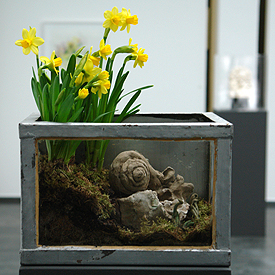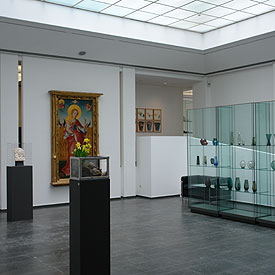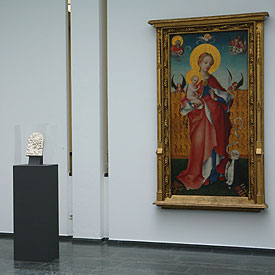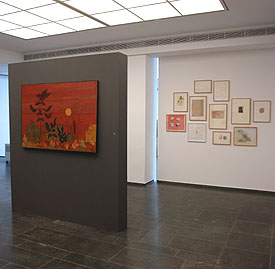2006 In the Garden of Reality I
14 April to 16 October 2006
In the Garden of Reality I
Sterne für Kolumba – Part 11
Over the past 15 years the painting „The Virgin with the Violet“ by Stefan Lochner (its name deriving from the little flower the Mother of God holds in her hand as a symbol of humility) has been on display throughout all of our exhibitions, in changing dialogues with other works of art. Now, in our final exhibition at the old location before moving into our new building, the painting stands at the centre of attention surrounded by a garden spread out to her honour. On closer inspection her garden is a field of blossoming and fruit-bearing strawberries, which identifies it as paradise. In this garden the picture’s patron, Elisabeth of Reichenstein, the abbess of St. Cecilia Endowment for Ladies of Rank in Cologne, is shown kneeling in veneration. Surrounded by the heavenly sphere of God the Father, the Holy Ghost and several angels, she worships the Virgin and the Child. The two angels on either side of the Mother of God connect the two different levels of reality by leading the spectator’s eye towards the Virgin as well as to the patron. The almost abstract structure of the picture consists of three parts. A curtain made of brocade in the middle blocks the view of the sky, but at the same time playfully connects the supposed garden of reality with the visible reality of faith. With the apparent realism of the painting and its heavenly order the entire exhibition is centred around the unity of Creation and the longing for paradise, which begins with the moment of loss, the Fall of Man. A marvellous alabaster relief depicting this moment has only just been donated to the museum. Two paintings by Josef Albers and Walter Ophey round out this dialogue central to the exhibition concerning the merely supposed contradiction between abstraction and concrete depiction. Albers’ “Homage to the Square” (1962) and Ophey’s “Kalkwerk” (1928) are pictorial models for transcending a reality that may be experienced. In addition, in keeping with all of the other exhibitions over the past years this exhibition, showing works from six centuries, deals with existential questions. As a changing exhibition fed only by works from our own collection, our concept of the “living museum” is put to the test here for the last time at this location. In the graphics cabinet, which will (hopefully) grow and flourish like a garden during the year, works made by people suffering from trauma during a one-year workshop organized by Kolumba in co-operation with the local “Caritasverband” and the “Sozialdienst katholischer Frauen” are interwoven with works by well-known artists.
(Works by Josef Albers, Joseph Beuys, Stephan Baumkötter, Victoria Bell, Heinrich Commans, Gérard Gasiorowski, Bärbel Messmann, Walter Ophey, Paul Thek, Peter Tollens, Andor Weininger)
In the Garden of Reality I
Sterne für Kolumba – Part 11
Over the past 15 years the painting „The Virgin with the Violet“ by Stefan Lochner (its name deriving from the little flower the Mother of God holds in her hand as a symbol of humility) has been on display throughout all of our exhibitions, in changing dialogues with other works of art. Now, in our final exhibition at the old location before moving into our new building, the painting stands at the centre of attention surrounded by a garden spread out to her honour. On closer inspection her garden is a field of blossoming and fruit-bearing strawberries, which identifies it as paradise. In this garden the picture’s patron, Elisabeth of Reichenstein, the abbess of St. Cecilia Endowment for Ladies of Rank in Cologne, is shown kneeling in veneration. Surrounded by the heavenly sphere of God the Father, the Holy Ghost and several angels, she worships the Virgin and the Child. The two angels on either side of the Mother of God connect the two different levels of reality by leading the spectator’s eye towards the Virgin as well as to the patron. The almost abstract structure of the picture consists of three parts. A curtain made of brocade in the middle blocks the view of the sky, but at the same time playfully connects the supposed garden of reality with the visible reality of faith. With the apparent realism of the painting and its heavenly order the entire exhibition is centred around the unity of Creation and the longing for paradise, which begins with the moment of loss, the Fall of Man. A marvellous alabaster relief depicting this moment has only just been donated to the museum. Two paintings by Josef Albers and Walter Ophey round out this dialogue central to the exhibition concerning the merely supposed contradiction between abstraction and concrete depiction. Albers’ “Homage to the Square” (1962) and Ophey’s “Kalkwerk” (1928) are pictorial models for transcending a reality that may be experienced. In addition, in keeping with all of the other exhibitions over the past years this exhibition, showing works from six centuries, deals with existential questions. As a changing exhibition fed only by works from our own collection, our concept of the “living museum” is put to the test here for the last time at this location. In the graphics cabinet, which will (hopefully) grow and flourish like a garden during the year, works made by people suffering from trauma during a one-year workshop organized by Kolumba in co-operation with the local “Caritasverband” and the “Sozialdienst katholischer Frauen” are interwoven with works by well-known artists.
(Works by Josef Albers, Joseph Beuys, Stephan Baumkötter, Victoria Bell, Heinrich Commans, Gérard Gasiorowski, Bärbel Messmann, Walter Ophey, Paul Thek, Peter Tollens, Andor Weininger)



